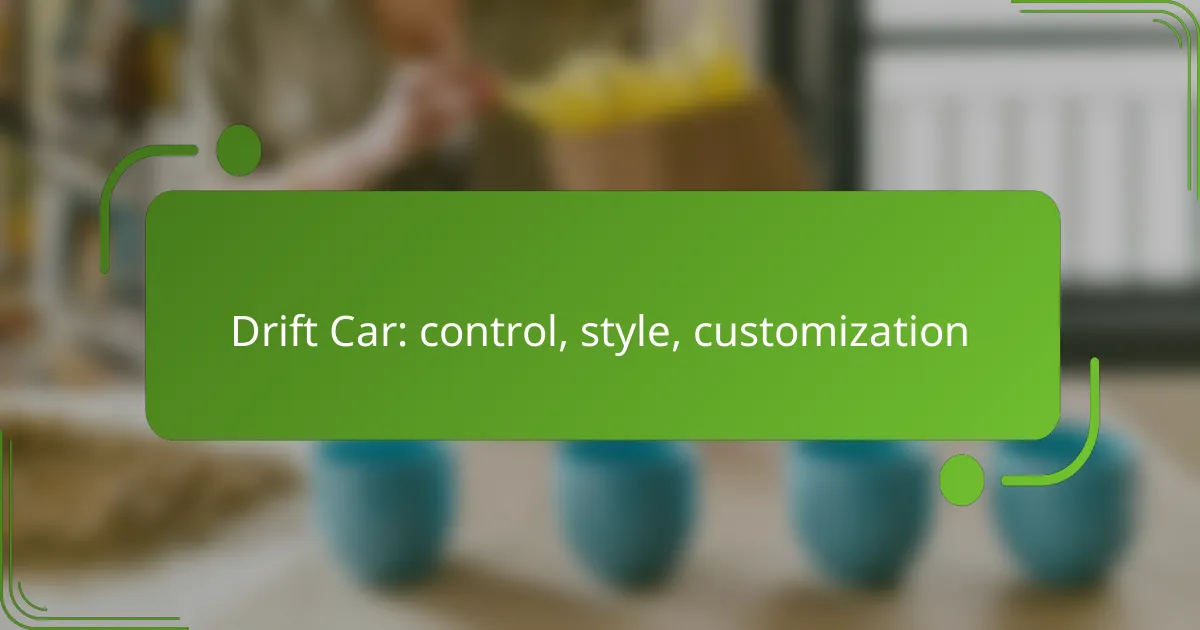Drift cars are a thrilling blend of control, style, and customization, essential for executing impressive maneuvers on the track. Mastering throttle management and steering techniques is crucial for maintaining control during stylish drifts, while popular models like the Nissan 240SX and Ford Mustang offer ample opportunities for performance upgrades and aesthetic enhancements. Customizing your drift car not only boosts its performance but also allows you to express your unique style through visual modifications and distinctive designs.

How to control a drift car in Canada?
Controlling a drift car in Canada requires a combination of precise throttle management, steering techniques, and an understanding of weight transfer. Mastering these elements allows drivers to maintain control while executing stylish drifts on various surfaces.
Throttle control techniques
Effective throttle control is crucial for maintaining drift stability. Smooth and gradual application of the throttle helps to balance power and traction, preventing loss of control. Aim for a steady increase in throttle as you initiate the drift, typically around 50-70% throttle depending on the car’s setup and surface conditions.
Common pitfalls include sudden throttle inputs that can lead to oversteer or loss of grip. Practice feathering the throttle to find the sweet spot where the rear tires maintain a controlled slide without spinning out.
Steering input adjustments
Steering input is essential for guiding the car during a drift. Quick, precise movements help to adjust the angle of the car and maintain the desired trajectory. When initiating a drift, turn the steering wheel sharply in the direction of the turn, then counter-steer as the rear begins to slide.
Be mindful of oversteering, which can cause the car to spin out. A good rule of thumb is to practice smooth, controlled steering adjustments, allowing the car to respond naturally to your inputs.
Weight transfer management
Managing weight transfer is key to maintaining control during a drift. Shifting weight from the front to the rear tires enhances grip on the back wheels, which is essential for maintaining a slide. Techniques like braking before a turn can help shift weight forward, allowing for a smoother transition into the drift.
Understanding how your car’s suspension affects weight transfer can also improve your drifting skills. Experiment with different setups and adjustments to find what works best for your vehicle and driving style.
Drift racing schools in Canada
Enrolling in a drift racing school can significantly enhance your drifting skills. Schools across Canada offer hands-on training with experienced instructors who provide valuable feedback and techniques. Look for programs that cover both theory and practical driving exercises.
Some notable drift schools include the Canadian Drift School and Drift Academy, which offer courses tailored to various skill levels. Prices typically range from a few hundred to over a thousand Canadian dollars, depending on the duration and depth of the program.

What are the best drift car models for customization?
The best drift car models for customization typically include vehicles that offer a strong aftermarket support, allowing enthusiasts to modify performance and aesthetics effectively. Popular choices include the Nissan 240SX, Ford Mustang, and BMW M3, each providing unique opportunities for upgrades and personal style.
Nissan 240SX modifications
The Nissan 240SX is renowned for its lightweight chassis and rear-wheel-drive layout, making it a favorite among drifters. Common modifications include upgrading the suspension with coilovers for improved handling and installing a turbocharger to boost engine power.
Additionally, enhancing the differential with a limited-slip option can significantly improve traction during drifts. Consider also lightweight wheels and performance tires to reduce weight and increase grip on the track.
Ford Mustang drift setups
The Ford Mustang, especially models from the 2015 generation onward, offers a robust platform for drifting. Key modifications often start with suspension upgrades, such as adjustable shocks and sway bars, to enhance stability and control during maneuvers.
Engine tuning is another crucial aspect, where options like cold air intakes and performance exhaust systems can increase horsepower. A rear differential upgrade, such as a 3.73 or 4.10 gear ratio, can also help in achieving better acceleration out of corners.
BMW M3 customization options
The BMW M3 is celebrated for its balance and precision, making it an excellent choice for drifting. Customization often begins with suspension modifications, including adjustable coilovers and camber plates to fine-tune handling characteristics.
Performance enhancements can include remapping the ECU for increased power and torque, along with upgrading the exhaust system for better airflow. Additionally, installing a high-performance brake kit can ensure reliable stopping power during aggressive driving.

How to style your drift car for competitions?
Styling your drift car for competitions involves a combination of visual appeal and performance enhancement. Focus on unique designs, body kits, and lighting modifications that reflect your personal style while adhering to competition regulations.
Popular vinyl wrap designs
Vinyl wraps are a popular choice for customizing the appearance of drift cars, offering a wide range of colors and patterns. Common designs include matte finishes, metallic sheens, and bold graphics that stand out on the track. Consider using designs that not only look good but also represent your brand or personality.
When selecting a vinyl wrap, ensure it is durable and suitable for outdoor conditions. High-quality wraps can last several years and withstand the rigors of drifting, while cheaper options may fade or peel quickly.
Essential body kits for drift cars
Body kits are crucial for enhancing both the aesthetics and aerodynamics of your drift car. Popular components include front bumpers, side skirts, and rear diffusers that improve downforce and stability during high-speed maneuvers. Look for kits specifically designed for your car model to ensure proper fitment and functionality.
When choosing a body kit, consider the material—fiberglass is lightweight but can be fragile, while polyurethane offers more durability. Balance style with performance to achieve the best results on the track.
Lighting modifications for aesthetics
Lighting modifications can significantly enhance the visual appeal of your drift car. LED strips, underglow kits, and custom headlights allow for creative expression and can make your vehicle stand out during night events. Choose colors that complement your overall design theme.
Be mindful of local regulations regarding lighting modifications, as some areas have restrictions on colors and brightness. Ensure your lighting upgrades are not only stylish but also safe and compliant with competition rules.

What are the key customization options for drift cars?
Drift cars can be customized in various ways to enhance control, style, and performance. Key options include suspension upgrades, engine tuning, and tire selection, each playing a crucial role in a car’s drifting capability.
Suspension upgrades
Upgrading the suspension is vital for improving a drift car’s handling and stability. Adjustable coilovers are popular, allowing drivers to fine-tune ride height and damping settings for optimal performance on the track.
Consider options like sway bars and strut braces, which can reduce body roll and enhance cornering grip. A well-tuned suspension setup can significantly affect how the car responds during a drift, making it easier to control slides.
Engine tuning choices
Engine tuning is essential for maximizing power and torque, which are critical for effective drifting. Common modifications include remapping the ECU, upgrading the turbocharger, or installing performance exhaust systems to improve airflow.
Drivers should balance power gains with reliability; excessive tuning can lead to engine strain. A well-tuned engine should provide a smooth power delivery, allowing for better throttle control during drifts.
Tire selection for drifting
Choosing the right tires is crucial for achieving the desired drift characteristics. Tires designed for drifting typically have a softer compound, providing better grip during slides while allowing for controlled oversteer.
Consider using a mix of tires for practice and competition; harder tires may be suitable for practice sessions, while softer tires can enhance performance during competitive events. Regularly check tire wear, as maintaining optimal tread depth is key to consistent drifting performance.

What factors should you consider when choosing a drift car?
When selecting a drift car, consider factors such as performance, handling, and your personal budget. The right car should balance power, weight distribution, and customization potential to suit your drifting style.
Budget considerations
Your budget is a crucial factor when choosing a drift car, as it impacts not only the initial purchase but also ongoing maintenance and modifications. Typically, a decent entry-level drift car can range from a few thousand to around ten thousand USD, depending on the make and model.
Factor in additional costs for upgrades, tires, and repairs, which can add up quickly. It’s wise to set aside a portion of your budget specifically for modifications that enhance performance, such as suspension upgrades or engine tuning.
Consider buying a used car to save money, but ensure it has a solid maintenance history. Always inspect the vehicle thoroughly or have a trusted mechanic evaluate it before purchase to avoid costly surprises later on.
